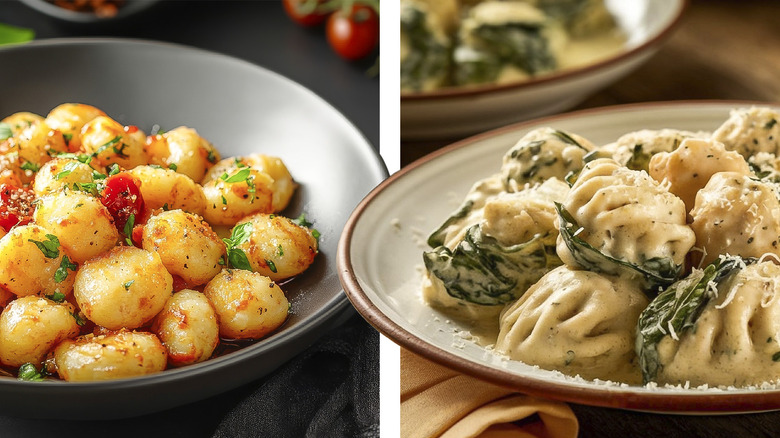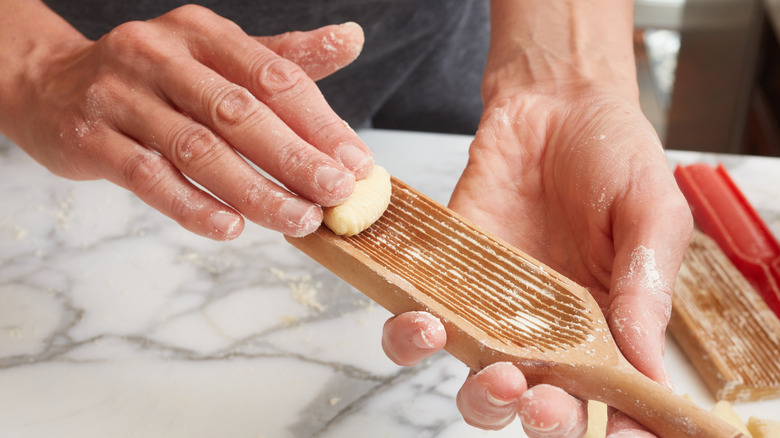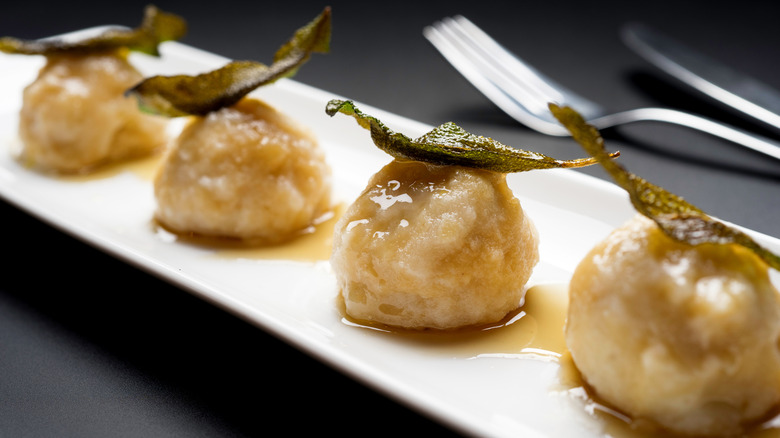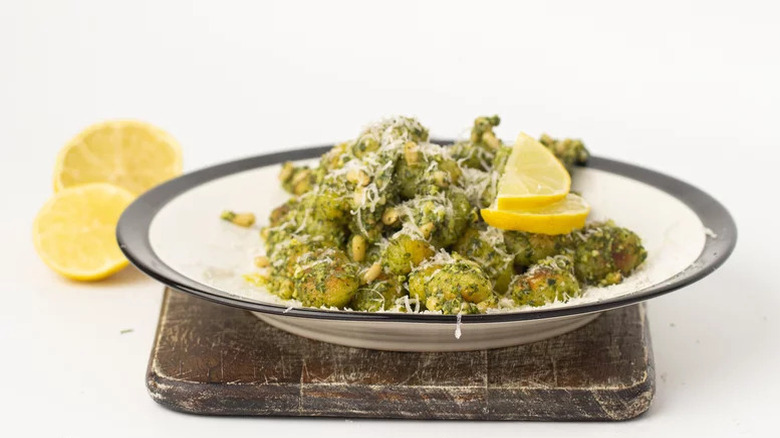Gnocchi Vs Gnudi: The Difference Between Dumpling Pastas
Simple, tasty Italian dishes are plentiful within the universe of dumpling pastas, or "pasta ripiena" in Italian. Two favorites include gnocchi and gnudi, both easy to make and even easier to eat. Recipes for both of these magical pasta dumplings have been around for centuries, and are often supplemented with a simple tomato sauce or tossed with brown butter and a little sage to make a complete meal. Don't worry, though. You can pair them with many different and delicious sauces. Easy, cream-cheese sauce is perfection in this sheet pan gnocchi with chicken and broccoli. And speaking of yummy one-dish meals, this sheet pan ricotta gnudi recipe doesn't use a sauce at all.
Gnocchi and gnudi utilize eggs to make everything stick together but then travel different paths. It's their function that counts the most, though. Clever, utilitarian beginnings as ways to use up bits of ingredients, like potatoes and cheese, make both of these dumpling pastas economical meals that look and taste fancy. It all comes down to your mood and just how many carbs you want to consume.
Gnocchi is made with potatoes
For authentic gnocchi that's light (and never tough), using boiled white potatoes processed in a food mill or ricer is the way. The white potato pulp resembles flour to make the gnocchi look like pasta. Use a starchier potato, like an older Russet or Yukon Gold that needs to go. Older potatoes are drier because potatoes lose moisture as they age. A potato with a substantial amount of water will require more flour to soak up the water, and that's how you make tough gnocchi. Just a little flour will do to get that succulent, spongy texture that bounces back a little when you push the dough with your finger.
You can also bake the potatoes to make gnocchi. Whether you boil or bake them, let them cool before forming the gnocchi dough. The potatoes give this pasta its strength, and that's why it's rolled into a log and cut into little nuggets. Use a fork or a gnocchi board to make indentations in the gnocchi. This is a must. That's how they soak up whatever super delicious sauce you pair with it. You can add other ingredients to your gnocchi to infuse all sorts of flavors and textures. We dream about this divine recipe for carrot gnocchi in walnut butter.
Gnudi is all about the cheese
Gnudi is an ultra-light dumpling from Tuscany that's barely a dumpling at all. Its name translates to "naked", and they are fittingly nicknamed "naked ravioli". Airy and light, these dumplings can be made with or without flour. If flour is used, it's minimal, because it's all about the cheese here, mostly ricotta and sometimes a little Parmigiano Reggiano. In other parts of Tuscany, this dumpling is also called "malfatti", (translating to "badly made") and refers to gnudi's rustic, inconsistent shape. There's no rolling here, just mixing and forming these dumplings with your hands or a quenelle spoon. Spinach or Swiss chard are popular add-ins; just be sure to squeeze out all the water from either one if you're using frozen versions or saute and drain either green to remove as much moisture as possible. Otherwise, each gnudi will fall apart as you poach it. They are usually refrigerated for 24 hours to dry them out before simmering them in boiling water for six to seven minutes. They are sometimes baked in the oven after blanching them to set them a bit.
Gnocchi can be fried all the ways
While both gnocchi and gnudi can be poached, gnocchi can be pan-fried. Poach them first, drain them, and then brown them up beautifully on both sides in our crispy gnocchi recipe that uses pesto to coat them for a stellar finishing touch. Gnocchi is hearty enough to handle two cooking methods, actually three, if you count the potatoes being boiled or baked before becoming the best part of the dough. Don't forget about sweet potatoes if you're considering a pan-fried approach. Toss those crispy orange delights in brown butter, like we did in this sweet potato gnocchi recipe with a dollop of lemony ricotta. It's just the thing to whip up whenever you're short on time but craving Italian fare.
Deep-frying gnocchi is also a thing because, well, anything can be deep-fried if you put in the effort. The secret is to freeze the gnocchi. This will make them crispy on the outside and puffy on the inside. Fry them at 350 degrees Fahrenheit until they brown and then dust them in finely grated Romano or Parmesan cheese to make them extra yummy. Serve them with marinara and (wait for it) buttermilk ranch dressing for dipping.



